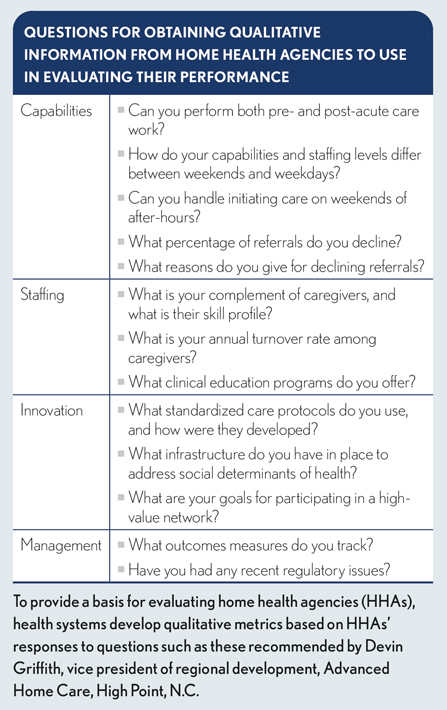Health systems should leverage both external and internal sources of qualitative data on post-acute care (PAC) providers. They should engage PAC providers in efforts to gather qualitative data. One way to do so is to have providers participate in site visits to skilled nursing facilities (SNFs), where the agenda for the visits includes a review of sample care plans and discussions with management teams.
Site visits and qualitative surveys can deepen the due diligence process, allowing a health system to identify PAC providers whose historical data does not reflect their current performance on cost or quality.
For example, both Lovelace Health System in Albuquerque, N.M., and LifePoint Health, based in Brentwood, Tenn., recommend using case managers and other staff with knowledge of various partner candidates among PAC providers to gather qualitative data.
Chris Frost, MD, national medical director of hospital-based providers for LifePoint, recommends systematically collecting the following data from case managers for SNFs:
- Response to referral request within 24 hours
- Total bed capacity
- Interaction or non-interaction with the hospital’s case management portal
- Working relationship with the SNF
- Recent changes in ownership or management
This is not a one-way process. Once the network is up and running, participating PAC providers should receive a provider-specific scorecard like what internal staff receive monthly or quarterly. At LifePoint, blinded results often are presented at quarterly PAC network open forums where performance is discussed.
Although a scorecard can be populated with claims data, many health systems require the participating PAC provider to submit specific data to improve the timeliness of evaluation and feedback. Typically, data elements for a PAC provider in a network created by a participant in the Bundled Payment for Care Improvement (BPCI) initiative (now BPCI Advanced) include the following:
- The number of patients the PAC provider received by episode
- The estimated net payment reconciliation amount
- The number of readmissions
- PAC length of stay (for SNFs)
- Use of secondary PAC settings
- First PAC as a percentage of target price
- Current star rating from the Centers for Medicare & Medicaid Services
Providing network participants with quantitative data and providing a forum for discussion allows for the identification of additional opportunities to improve care coordination.






